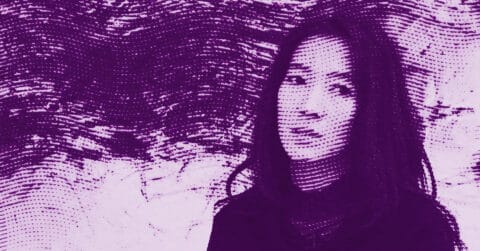Listen to me carefully, you bunch of snobs, it is high time to talk about an artist who made her marginality an unparalleled creative force. Takako Yamaguchi, this Los Angeles-based painter, has spent over four decades creating art that defies our expectations with provocative elegance. If you think I am going to give you yet another formatted analysis of an Asian artist who paints waves and clouds, think again. Yamaguchi is a sophisticated rebel who turns clichés into gold, literally, as she uses bronze leaves in her recent works.
Beyond any easy label or quick categorization, Yamaguchi carves her own path with quiet determination. Her recent paintings, exhibited at Ortuzar Projects, are monumental compositions measuring 150 by 100 centimeters that transcend the boundaries between abstraction and figuration. These works immerse us in a universe where waves are no longer simply waves, but signs of a sophisticated visual language that challenges our very relationship to representation.
What is interesting in Yamaguchi’s work is that she creates what Jean Baudrillard would call “simulacra,” images that no longer represent reality but become their own reality. Her seascapes do not seek to imitate nature, they create a new nature, a new visual order that exists alongside the real world. When she paints a wave, it is not a reproduction of a real wave, but rather the very idea of the wave, transformed by her imagination into something more complex and ambiguous.
This approach to simulacra is particularly evident in her series of hyperrealistic self-portraits from the 2010s. These paintings, which show fragments of her body dressed in meticulously detailed blouses and cardigans, push realism to a point where it tips into the hyperreal. Every fold of fabric, every button, every embroidery stitch is rendered with such obsessive precision that these images transcend their representative function to become autonomous objects, parallel realities that make us doubt our own perception.
Baudrillard’s concept of simulacra helps us understand how Yamaguchi uses technical precision not to imitate reality, but to create a new form of pictorial reality. In her paintings, clothes are no longer just clothes, but complex architectures of fabric that become landscapes in themselves. The folds and textures are rendered with such exactness that they cease to be representations and become autonomous presences on the canvas.
This hyperreal dimension of her work is reinforced by her technique of the “punctum,” a concept borrowed from Roland Barthes which designates a detail in an image that pierces us, disturbs us, moves us. In Yamaguchi’s works, the punctum is not a single element but a constellation of details that create a constant tension between the familiar and the strange, the real and the artificial.
Take, for example, her recent seascapes. At first glance, they seem to depict natural scenes, waves, clouds, horizons. But on closer inspection, one discovers that every element is stylized, geometrized, transformed into a pattern that oscillates between abstraction and figuration. The waves repeat like kimono patterns, the clouds braid like hair, the rain falls in perfectly straight lines. Nature itself becomes an alphabet that the artist uses to write her own visual poems.
This approach makes Yamaguchi a deeply contemporary artist, even if her technique may seem traditional. She understands that in our image-saturated world, the question is no longer to represent reality but to create new visual realities that make us reflect on our relationship to images. Her paintings are not windows onto the world but mirrors reflecting our own expectations and prejudices about what art should be.
Her use of gold leaf in her recent works adds another dimension to this exploration. The metallic material creates shifting reflections that transform the surface of the painting into a dynamic, unstable space that refuses to settle into a single interpretation. It’s as if the artist is telling us that even the surface of a painting is not a fixed datum but a space of infinite possibilities.
Critics have often tried to categorize Yamaguchi by associating her with the Pattern & Decoration movement of the 1970s. But this association, although not without relevance, does not do justice to the complexity of her approach. Certainly, she shares with this movement an interest in decorative arts and a desire to rehabilitate marginalized artistic traditions. But her approach goes far beyond a mere rehabilitation of the decorative.
What distinguishes Yamaguchi is her ability to create what she calls “reverse abstractions.” Instead of following the traditional path of modern art that moves from figuration to abstraction, she starts from abstraction to return to a form of ambiguous figuration. This approach is not a mere formal exercise but a deep reflection on the very nature of representation in contemporary art.
In her recent paintings, this approach reaches a new maturity. The seascapes she creates are not simply blends of Eastern and Western styles, but entirely new pictorial spaces where artistic traditions dissolve to form something unprecedented.
The artist develops what she calls a “poetics of dissidence,” an approach that involves working with elements considered minor or marginal by the official history of art. She is interested in the “rejects of abandoned ideals,” as she herself says, transforming what has been rejected by modernism, decoration, fashion, beauty, sentimentality, into raw material for her art.
This strategy is particularly evident in her “Smoking Women” series from the 1990s, which has recently reached record prices at auctions. These paintings, which blend references to Art Deco, Japanese prints, and pop culture, create a visual universe where clichés about exoticism and femininity are subtly subverted. The smoking woman, traditionally a symbol of Western decadence, is reinvented through the prism of a transcultural aesthetic.
Yamaguchi’s late success on the art market, with some of her works now exceeding one million euros at auctions, is both a well-deserved recognition and an irony of fate. For her work has always been a subtle critique of market values and cultural hierarchies that dominate the art world.
In her Los Angeles studio, she continues to produce about seven paintings per year, each requiring months of meticulous work. This deliberate slowness is in itself an act of resistance in our era of constant acceleration. Each painting is the result of prolonged meditation on the nature of art, identity, and representation.
The works exhibited in 2024 at the Whitney Museum of American Art Biennial show that she continues to reinvent herself. Her new paintings incorporate weather motifs: clouds, waves, rain, but in a way that transcends mere representation. These are natural phenomena seen through the prism of artistic imagination, transformed into signs of a personal visual language.
The use of geometry in these paintings is particularly sophisticated. The zigzags, spirals, braids that run through her compositions are not simple decorative motifs, but structural elements that organize the pictorial space according to a logic that is neither entirely Western nor wholly Eastern. It is as if Yamaguchi invented a new visual syntax, capable of expressing ideas that escape the traditional language of painting.
There is something deeply political in this approach, even if it is not immediately obvious. By refusing to conform to expectations, mixing traditions with total freedom, Yamaguchi challenges established cultural hierarchies. She does so not aggressively or didactically, but with a subtlety that makes her message all the more powerful.
Her work reminds us that art is not a closed system with fixed rules, but a space of infinite possibilities. When she paints a wave, it is not just a wave; it is a philosophical proposition on the nature of representation, a reflection on cultural identity, an exploration of the boundaries between abstraction and figuration.
This complexity is reflected in her painting technique. Yamaguchi works with an almost scientific precision, building her paintings layer by layer, detail by detail. But this technical rigor is never an end in itself. It is put at the service of an artistic vision that seeks to create not images of the world, but worlds in images.
Institutional recognition is finally beginning to follow commercial success. The Museum of Contemporary Art in Los Angeles is preparing a major solo exhibition of her work, “MOCA Focus: Takako Yamaguchi,” which will open in June 2025. This exhibition will be an opportunity to see how the different periods of her work articulate and respond to each other, forming a coherent body despite its apparent diversity.
In the meantime, her works continue to challenge us about the very nature of art and representation. In a world saturated with images, where reality and its representation increasingly blur, Yamaguchi’s work reminds us that painting can still be a space of resistance and critical reflection.
The time has come to recognize Takako Yamaguchi not simply as a skilled practitioner, but as one of the most sophisticated and original artists of our time. Her work shows us that it is possible to create art that is both deeply personal and universally significant, technically virtuosic and conceptually complex.
So next time you find yourself before one of her paintings, take the time to really look. Let yourself be carried by the rhythm of her geometric waves, lose yourself in her impossible skies, meditate on her horizons which are as many frontiers to cross. For in Yamaguchi’s art, each painting is an invitation to rethink our relationship to image, identity, and beauty itself.
















